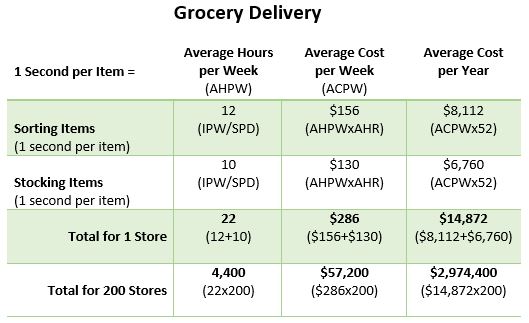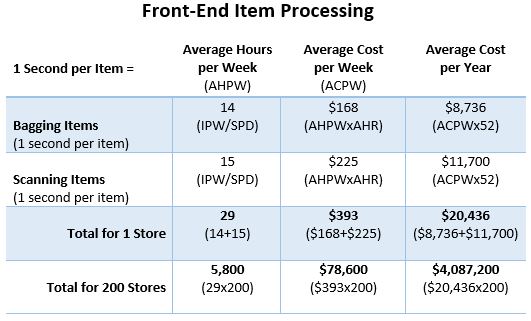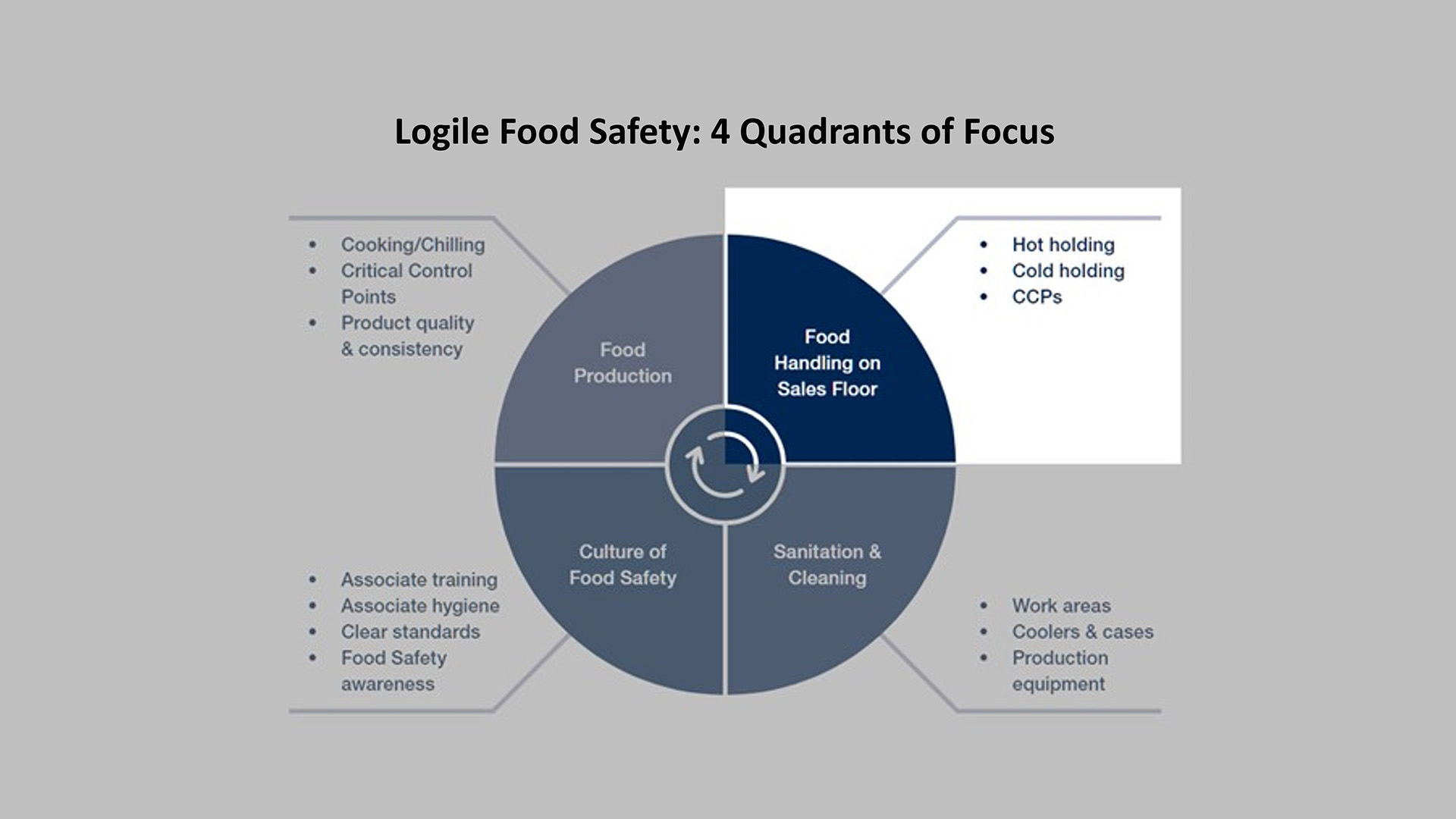Kathleen O’Reilly, Training Specialist
Jim Wegeleben, Senior Manager Logile Academy
This is our final blog post in the series “What’s it Worth.” Previously, we explored the notion of what One Minute. One Item. What’s It Worth? and One Second per Customer: What’s it Worth? Now let’s consider what “One Second Per Item” is worth in your organization. What could happen if you were to remove one second for every item handled by your grocery crews and from your front registers?
The numbers
When you think about the product coming into your stores, have you considered the possibility of a more efficient way to handle the items that are being received weekly? Efficiency as to how product is received, sorted—or not sorted—and stocked onto the sales floor or backrooms is key. The same thing goes with how your customer is handled at the front end. The basic idea is product is ordered, shipped, unloaded and stocked for your customers to purchase. Finally, product is scanned and bagged then carried or rolled out the front door. Seems simple, but this can still be somewhat of a mystery to most organizations. We’ll focus on two areas of handling the items: first sorting and stocking the items/cases, and then scanning and bagging.
How much time is being spent handling the items/cases that are received by your stores? A story you may have heard is, “Our stocking crew processes the product effectively.” This may or may not be true, but the biggest question to ask yourself as a labor manager is “Are the stores using the time properly?” For example, let’s say a stocking crew received a delivery with a piece count of 1,200 cases, and it took the crew of 5 stockers about 7 hours to process (approximately 34 cases per hour.) Then on the following delivery of the week, with a piece count of 800 cases, it took the same stocking crew of 5 stockers about 7 hours to process (approximately 23 cases per hour.) So, what is causing the difference in productivity?
The expectation of a stocking crew is to be efficient and productive, which requires having the appropriate requirements in the labor standards. Fundamental labor manager process questions include:
- Is the stocking crew working additional stock from the back because of the fewer piece count of the delivery?
- What processes are being executed to break down the delivery?
- What steps are actually being taken to put the delivery onto the sales floor?
By reflecting, observing, quantifying and breaking processes down into their smallest components—by asking yourself “Do I know what is happening and why?”—you can start to discover and then put together a strategic, actionable plan.
It’s worth repeating that a labor manager’s role is to help the organization identify incurred costs along with offering possible cost-saving alternatives. Explicitly knowing what a second costs brings you one step closer toward fine-tuning the organization’s expenses while effectively managing your workforce. The goal is to drill down to quantify one second per item’s worth when sorting and stocking product on a load and bagging and scanning on the front-end registers.
Product deliveries: Doing the math
We begin by identifying the processes involved with exactly how a delivery is received, sorted and placed onto the sales floor for your customers. This is done because a delivery’s sorting and stocking efficiency/inefficiency can have a big impact on the labor.
Let’s think about the 1,200 and 800 cases mentioned above and then calculate these deliveries into items:
- 1,200 cases x 12 (average items per case) = 14,400 items
- 800 cases x 12 (average items per case) = 9,600 items
Next, we introduce a few constant baseline metrics:
- 1 = 1 store
- 200 = 200 stores
- IPW = Average # Items per Week is 43,200 (approximately 3 deliveries x 14,400 items)
- AHR = (Average Hourly Rate) $13.00 per hour
- SPD = (Seconds per Day) 60×60=3,600
wp:heading {“level”:6} –>
Example #1: One second per item of product delivery processing time
Now let’s focus on the sorting and stocking of the items/cases in the weekly delivery of product. The average time we are using for sorting is 7.10 seconds per item, and for stocking is 7.32 seconds per item. In this example, let’s note that 100 percent of the items are being sorted, and 85 percent of the items are being stocked.
wp:image {“align”:”center”,”id”:16710,”sizeSlug”:”full”,”linkDestination”:”none”} –>

What is illustrated is one second per item for grocery is worth around 22 hours per store per week. In larger corporations those hours multiply to add up to significant numbers rather quickly. In the example above, a potential total of approximately 4,400 hours removed and over $2,974,400 a year in labor cost could be saved!
Front-end registers: More math
Organizations handle the scanning and bagging differently, especially the bagging. One organization will have the cashiers scan the items and the customers will handle the bagging themselves. The other extreme is the cashier will scan the items and another clerk will bag the items. Of course, either way is usually the decision of your organization and not something you are able to change. However, it’s the labor manager’s job to know exactly where and how the labor is being spent and accounted for.
In our next example, let’s consider what one second for one item is could potentially be worth. If a cashier could scan one item one second faster would that improve the customer through-put at the registers? If a bagger could place one item in a bag one second quicker would that improve the customer service with each customer?
wp:heading {“level”:6} –>
Example #2: One second per item bagging and scanning time
Let’s now consider a standard process of bagging items at the registers. The clerk will grab the items after the cashier has scanned them, and place one or two at a time into a bag for the customer. The average time we are using for bagging is 3.89 seconds per item, and for scanning is 3.35 6.63 seconds per item. (3.35 down to 2.5) Also note that 90 percent of the items are bagged, and 100 percent of the items are being scanned.
We begin with the constant baseline metrics:
- 1 = 1 store
- 200 = 200 stores
- IPW = Average # Items per Week is 55,000
- BAHR = (Bagger Average Hourly Rate) $12.00 per hour
- CAHR = (Cashier Average Hourly Rate) $15.00 per hour
- SPD = (Seconds per Day) 60×60=3600
wp:image {“align”:”center”,”id”:16711,”sizeSlug”:”full”,”linkDestination”:”none”} –>

Here we see that one second per item on a front end is worth 29 hours per store per week, and again in larger corporations that adds up very quickly to approximately 5,800 hours and over $4,087,200 a year in labor costs.
What’s It Worth?
So, what’s it worth? A lot. Know your numbers. Awareness allows you the opportunity to seek out and discover ways to fine-tune an operation. Time is money. Subtracting minutes and seconds may not seem like much on the surface, but as illustrated can translate into impressive cost savings for your organization!
Additional resources
As a Labor Team, you should always be looking for opportunities to save your organization money and help create a positive impact on the bottom line. If you are new to workforce management and task-based scheduling and would like to learn the basics, check out Logile’s Workforce Management Academy. Built by our labor experts and packed with industry best practices and lessons learned from decades of experience, we created WFM Academy to provide any retailer with a solid understanding of effective labor management key concepts. WFM Academy delivers the most comprehensive offering with engaging online and virtual-led instructor coursework that quickly turbocharges your team to start improving operational results. Learn more and get a sneak peek today!




